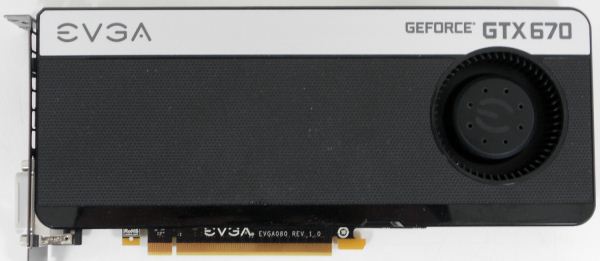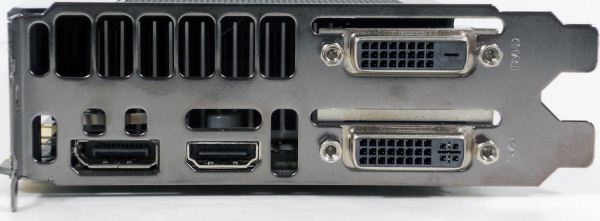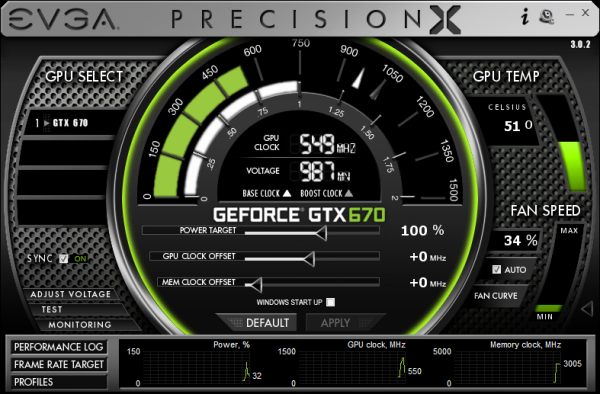NVIDIA GeForce GTX 670 Review Feat. EVGA: Bringing GK104 Down To $400
by Ryan Smith on May 10, 2012 9:00 AM ESTMeet The EVGA GeForce GTX 670 Superclocked
Our second card of the day is EVGA’s GeForce GTX 670 Superclocked, which in EVGA’s hierarchy is their first tier of factory overclocked cards. EVGA is binning GTX 670s and in turn promoting some of them to this tier, which means the GTX 670 Superclocked are equipped with generally better performing chips than the average reference card.
| GeForce GTX 670 Partner Card Specification Comparison | ||||
| EVGA GeForce GTX 670 Superclocked | GeForce GTX 670 (Ref) | |||
| CUDA Cores | 1344 | 1344 | ||
| Texture Units | 112 | 112 | ||
| ROPs | 32 | 32 | ||
| Base Clock | 967MHz | 915MHz | ||
| Boost Clock | 1046MHz | 980MHz | ||
| Memory Clock | 6210MHz | 6008MHz | ||
| Memory Bus Width | 256-bit | 256-bit | ||
| Frame Buffer | 2GB | 2GB | ||
| TDP | 170W | 170W | ||
| Manufacturing Process | TSMC 28nm | TSMC 28nm | ||
| Width | Double Slot | Double Slot | ||
| Length | 9.5" | 9.5" | ||
| Warranty | 3 Years | N/A | ||
| Price Point | $419 | $399 | ||
For the GTX 670 SC, EVGA has given both the core clock and memory clock a moderate boost. The core clock has been increased by 52MHz (6%) to 967MHz base and 66MHz (7%) boost to 1046MHz. Meanwhile the memory clock has been increased by 202MHz (3%) to 6210MHz.
Other than the clockspeed changes, the GTX 670 SC is an almost-reference card utilizing a reference PCB with a slightly modified cooler. EVGA is fabricating their own shroud, but they’ve copied NVIDIA’s reference shroud down to almost the last detail. The only functional difference is that the diameter of the fan intake is about 5mm less, otherwise the only difference is that EVGA has detailed it differently than NVIDIA and used some rounded corners in place of square corners.
The only other change you’ll notice is that EVGA is using their own high flow bracket in place of NVIDIA’s bracket. The high flow bracket cuts away as much metal as possible, maximizing the area of the vents. Though based on our power and temperature readings, this doesn’t seem to have notably impacted the GTX 670 SC.
While we’re on the matter of customized cards and factory overclocks, it’s worth reiterating NVIDIA’s position on factory overclocked cards. Reference and semi-custom cards (that is, cards using the reference PCB) must adhere to NVIDIA’s power target limits. For GTX 670 this is a 141W power target, with a maximum power target of 122% (170W). Fully custom cards with better power delivery circuitry can go higher, but not semi-custom cards. As a result the flexibility in building semi-custom cards comes down to binning. EVGA can bin better chips and use them in cards such as the Superclocked – such as our sample which can go 17 boost bins over the base clock versus 13 bins for our reference GTX 670 – but at the end of the day for stock performance they’re at the mercy of what can be accomplished within 141W/170W.
In any case, as the card is otherwise a reference GTX 670 EVGA is relying on the combination of their factory overclock, their toolset, and their strong reputation for support to carry the card. EVGA has priced the card at $419, $20 over the GTX 670 MSRP, in-line with other factory overclocked cards.
On the subject of pricing and warranties, since this is the first EVGA card we’ve reviewed since April 1st, this is a good time to go over the recent warranty changes EVGA has made.
Starting April 1st, EVGA has implemented what they’re calling their new Global Warranty Policy. Starting July 1st, 2011 (the policy is being backdated), all new EVGA cards ship with at least a 3 year warranty. And for the GTX 600 series specifically, so far EVGA has only offered models with a 3 year warranty in North America, which simplifies their product lineup.
To complement the 3 year warranty and replace the lack of longer term warranties, EVGA is now directly selling 2 and 7 year warranty extensions, for a total of 5 and 10 years respectively. So instead of buying a card with a 3 year warranty or a longer warranty, you’ll simply buy the 3 year card and then buy a warranty extension to go with it. However the extended warranty requires that the card be registered and the warranty purchased within 30 days.
The second change is that the base 3 year warranty no longer requires product registration. EVGA has other ways to entice buyers into registering, but they’ll now honor all applicable cards for 3 years regardless of the registration status. At the same time the base 3 year warranty is now a per-product warranty (e.g. a transferable warranty) rather than per-user warranty, so the base warranty will transfer to 2nd hand buyers. The extended warranties however will not.
The third change is how EVGA is actually going to handle the warranty process. First and foremost, EVGA is now allowing cards to be sent to the nearest EVGA RMA office rather than the office for the region the card was purchased from. For example a buyer moving from Europe to North America can send the card to EVGA’s North American offices rather than sending it overseas.
Finally, EVGA is now doing free cross shipping, alongside their existing Advanced RMA program. EVGA will now cross-ship replacement cards for free to buyers. The buyer meanwhile is responsible for paying to ship the faulty card back and putting up collateral on the new card until EVGA receives the old card.
There’s also one quick change to the step-up program that will impact some customers. With the move to purchasing extended warranties, the step-up program is only available to customers who either purchase an extended warranty or purchase an older generation card that comes with a lifetime warranty. Step-up is not available to cards with only the base 3 year warranty.
Moving on, along with EVGA’s new warranty EVGA is bundling the latest version of their GPU utilities, Precision X and OC Scanner X.
Precision X, as we touched upon quickly in our GTX 680 review, is the latest iteration of EVGA’s Precision overclocking & monitoring utility. It’s still based on RivaTuner and along with adding support for the GTX 600 series features (power targets, framerate caps, etc), it also introduces a new UI. Functionality wise it’s still at the top of the pack along with the similarly RivaTuner powered MSI Afterburner. Personally I’m not a fan of the new UI – circular UIs and sliders aren’t particularly easy to read – but it gets the job done.
OC Scanner X has also received a facelift and functionality upgrade of its own. Along with its basic FurMark-ish stress testing and error checking, it now also offers a basic CPU stress test and GPU benchmark.



















414 Comments
View All Comments
CeriseCogburn - Friday, May 11, 2012 - link
And let's add, since another amd fanboy has a big problem again - let's add, the great and "superior" amd Tahiti "gpu compute monster ! housefire !" gpu loses miserably in the compute benchmarks in this review, loses 3 tests to nVidia, to the gpu teh amd fanboys have spewed is very, very bad in compute compared to their loser amd 7970 core.Hey, how about that, now we both have some compute to talk about, and how amd is a loser failure, and nVidia won again, even in compute ! :)
Wow, I guess compute is really, really, really important like all the amd fanboys have been saying this entire thread.
CeriseCogburn - Friday, May 11, 2012 - link
Here's the idiot spew from you about compute on the prior page, amd fanboy: " Anyway, 7970 is a superior product over 680 if only for the compute performance it offers."LOL
It lost the benches here clueless.
ROFL
I love my amd fanboy friends.
versesuvius - Saturday, May 12, 2012 - link
Oh, you are back. Learned to read?Which benchmark are you talking about, know nothing imbecile? You are talking about this review? Are you trying to tell us that you cannot read or count? We already know that. Oh, you are trying to tell us that NVIDIA cannot get its act together even on the one benchmark that it has always done good, with 670 falling behind everyone? Hey, you are making progress. The NVIDIA way. Keep it up. You are doing fine.
CeriseCogburn - Sunday, May 13, 2012 - link
In this review nVidia won 3 compute benches and and won 2 compute benches.Nvidia 60%
amd 40%
Not like the very data here means anything to you.
Nfarce - Thursday, May 10, 2012 - link
One of my SLI 570s crapped out last month. Knowing the 670 was on the horizon but not willing to wait, I grabbed a 680 for $520 (EVGA Superclocked 2682 model - the only one that I could grab with F5 tapping). Looking at how close the 670 is to the 680, and (as of right now) looking at all the stock of 670s on Egg, I overspent by $100 when I could have had the Superclocked 670. I had no idea the performance was going to be that close.And who would have thought these things would actually be available? Kicking myself...kicking myself...
CeriseCogburn - Thursday, May 10, 2012 - link
At least you didn't spank out $579.99 plus tax and fees on the 7970 - which had a value drop off like rock from a cliff while official drivers were still absent.$130 plus tax and fees, crappy mismatched and total fail drivers, the usual strange and inexplicable crashing with ten fixes per incident any one of which may work "for a while" or with ones fingers crossed but you never know which one...
Yeah dude, I'm not feeling sorry for you.
Burticus - Thursday, May 10, 2012 - link
I like what I'm reading about the 670's performance and huge overclocking ability... but I'm sorry $400 is just too much for a video card for me. I am not the hardcore gamer I used to be, and sad to say I do a lot more on the console now than the PC. I mean when a card costs more than my car payment, that is just sad. For what? Bragging rights? 10 fps faster in Skyrim? Anything over 60 fps is pure gravy, people.Needs to get to $200 or less for this kid to get into the game. And I doubt 660 gets under that. I have a sneaky feeling they are going to make the 660 $299 and the 650 will be $199. Assuming a TI something doesn't pop up in the $250 range which probably will.
My "old" GTX 460 768mb can limp along for a few more months. Heh, that has been a good little card and it was only $150.
Nfarce - Thursday, May 10, 2012 - link
Well that's fine and dandy for you. But others have invested in 3 monitors and are running 5760x1080/1200 resolutions or one expensive one at a 2560x1440/1600. Older cards and especially sub-$400 cards just aren't going to run those kinds of resolutions with details up, which defeats the purpose of getting said monitors in the first place.PC gaming to play the latest and greatest maxed out never has been, nor will it ever be, cheap. I also am an avid console player (PS3). Dirt 3 and Crysis 2 on my PS3 and 55" LED looks like a PS2 game compared to it running DX11 on my PC with a 27" 2560x1440 LCD monitor and maxing out things with my 680.
SlyNine - Sunday, May 13, 2012 - link
I can get this 680GTX below 60FPS at 1080P. Op doesn't know what he's talking about.As far as console gaming. Its funny, you see screen shots and think that looks close. Than you actually play the games on both platforms and go, yea they look nothing alike.
dunce - Thursday, May 10, 2012 - link
I would like to see a 7970OC comparison? I was trying to find a 680 but gave up and got an 7970oc for $499 it's running at 1025Mhz and should be faster than a 680.